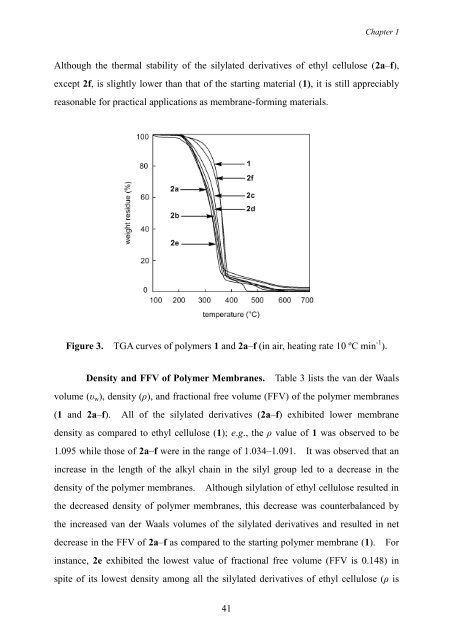Synthesis, Characterization, and Gas Permeation Properties
Synthesis, Characterization, and Gas Permeation Properties
Synthesis, Characterization, and Gas Permeation Properties
You also want an ePaper? Increase the reach of your titles
YUMPU automatically turns print PDFs into web optimized ePapers that Google loves.
41<br />
Chapter 1<br />
Although the thermal stability of the silylated derivatives of ethyl cellulose (2a–f),<br />
except 2f, is slightly lower than that of the starting material (1), it is still appreciably<br />
reasonable for practical applications as membrane-forming materials.<br />
Figure 3. TGA curves of polymers 1 <strong>and</strong> 2a–f (in air, heating rate 10 ºC min -1 ).<br />
Density <strong>and</strong> FFV of Polymer Membranes. Table 3 lists the van der Waals<br />
volume (υw), density (ρ), <strong>and</strong> fractional free volume (FFV) of the polymer membranes<br />
(1 <strong>and</strong> 2a–f). All of the silylated derivatives (2a–f) exhibited lower membrane<br />
density as compared to ethyl cellulose (1); e.g., the ρ value of 1 was observed to be<br />
1.095 while those of 2a–f were in the range of 1.034–1.091. It was observed that an<br />
increase in the length of the alkyl chain in the silyl group led to a decrease in the<br />
density of the polymer membranes. Although silylation of ethyl cellulose resulted in<br />
the decreased density of polymer membranes, this decrease was counterbalanced by<br />
the increased van der Waals volumes of the silylated derivatives <strong>and</strong> resulted in net<br />
decrease in the FFV of 2a–f as compared to the starting polymer membrane (1). For<br />
instance, 2e exhibited the lowest value of fractional free volume (FFV is 0.148) in<br />
spite of its lowest density among all the silylated derivatives of ethyl cellulose (ρ is

















